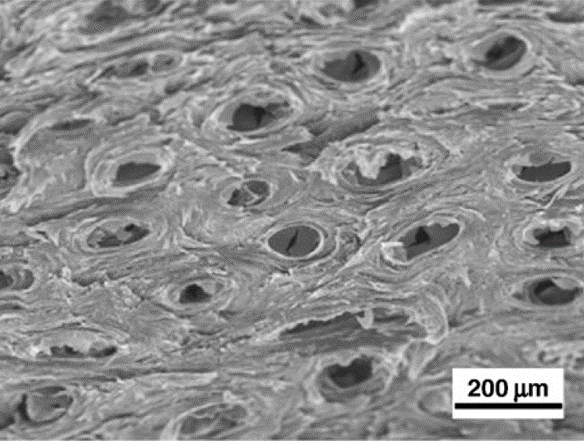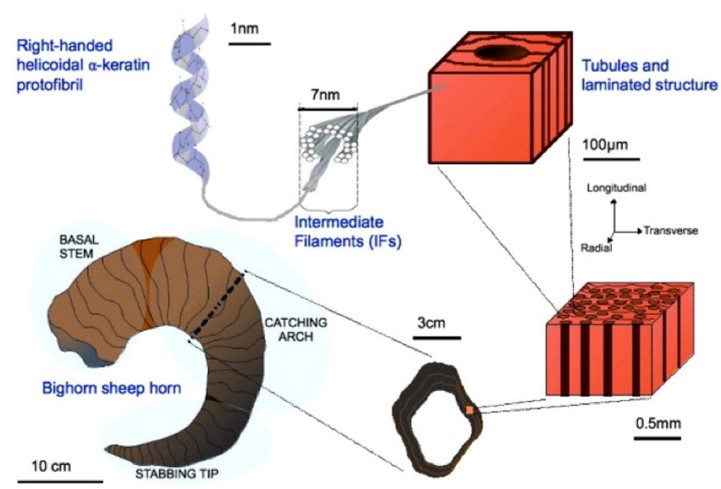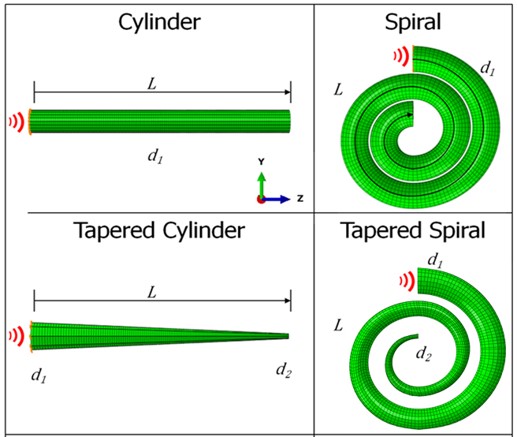Ram's Horns
During fights, the rams’ horns clash together at high speeds (up to 5.5 m/s), resulting in forces up to 3400 N. The remarkable resilience of horns, and the resulting well-being of the rams themselves, makes them an excellent study for CAVS researchers to investigate and understand damage-deterring mechanisms and impact- resistant materials in nature.
Header photo courtesy of Keith Martin
The horns of bighorn sheep consist of a core of cancellous bone covered with a germinative epithelium that generates new cell growth, all of which is surrounded by a sheath composed of α-keratin. The tubules in the bighorn sheep keratin typically form an elliptical shape with major and minor axes dimensions of 93 and 29.6 μm, respectively. Similar structures found in other biological structural materials such as bone, dentin or hoof in micro length scale would provide evidence for the importance of tubules in energy-absorbent materials design. The tubules provide toughening mechanisms, such as deflecting cracks, the energy to collapse tubules, and preventing extended regions of microbuckling of the laminates.


The horns consist of fibrous keratin tubules extending along the length of the horn and are contained within an amorphous keratin matrix. An increase in moisture content was found to increase ductility and decrease strength, as well as alter the stress state dependence of the material. The horn keratin demonstrated a significant strain rate dependence in both tension and compression, and also showed increased energy absorption in the hydrated condition at high strain rates when compared to quasi-static data, with increases of 114% in tension and 192% in compression. Compressive failure occurred by lamellar buckling in the longitudinal orientation followed by shear delamination. Tensile failure in the longitudinal orientation occurred by lamellar delamination combined with tubule pullout and fracture.
Through finite element simulations, we evaluated four different geometries with the same length and same initial cross-sectional diameter at the impact location in three-dimensional finite element analyses.
- A round cylinder
- A round cylinder tapered to a point
- A round cylinder that was spiraled in a two dimensional plane
- A round cylinder that was tapered and spiraled in a two dimensional plane

The results show that the tapered spiral geometry representing a ram’s horn mitigated the greatest amount of pressure and impulse (approximately 98% mitigation) when compared to the cylinder regardless of material type (elastic, plastic, and viscoelastic) and regardless of input pressure signature.The specimen taper effectively mitigated the stress wave as a result of uniaxial deformational processes and an induced shear that arose from its geometry.
References
- Johnson, K.L., Trim, M.W., Francis, D.K., Whittington, W.R., Miller, J.A., Bennett, C.E. and Horstemeyer, M.F., 2017. Moisture, anisotropy, stress state, and strain rate effects on bighorn sheep horn keratin mechanical properties. Acta biomaterialia, 48, pp.300-308.
- M.W. Trim, M.F. Horstemeyer, H. Rhee, H. El Kadiri, L.N. Williams, J.Liao, K.B. Walters, J. McKittrick, S.J. Park. The effects of water and microstructure on the mechanical properties of bighorn sheep (Ovis canadensis) horn keratin Acta Biomater., 7 (2011), pp. 1228-1240
- Johnson, K.L., Trim, M.W., Horstemeyer, M.F., Lee, N., Williams, L.N., Liao, J., Rhee, H. and Prabhu, R., 2014. Geometric effects on stress wave propagation. Journal of biomechanical engineering, 136(2), p.021023.
